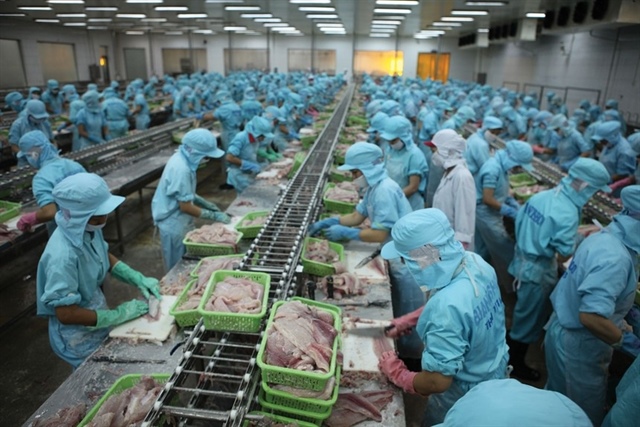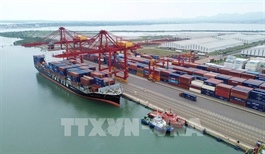Favourable tariff outlook offers boost for Vietnamese exporters
Favourable tariff outlook offers boost for Vietnamese exporters
As Vietnam and the United States advance towards a reciprocal trade agreement, expectations are growing for tariff cuts that could strengthen key export sectors and improve prospects for Vietnamese stocks.
On October 26, Vietnam and the United States agreed to issue a Joint Statement on the Framework for a Reciprocal, Fair, and Balanced Trade Agreement. The statement contained many encouraging details that have raised new expectations for Vietnam’s major export sectors.

Seafood, garments and textiles, and woodwork are among key export items to US market |
Both sides will continue discussions and implement steps towards completing the agreement, based on principles of openness, constructiveness, equality, ensuring mutual benefit and consideration of each side’s development level.
Speaking to VIR, Nguyen The Minh, head of Research at Yuanta Vietnam Securities, noted that during the suspension of reciprocal tariffs, the US signalled its intent to impose higher duties on technology products it can manufacture domestically.
In contrast, consumer goods that the US relies heavily on imports for may see tariff adjustments.
“Key sectors such as textiles and garments, processed foods, seafood, and fine wood products are those where the US remains import-dependent,” Minh said. “If high tariffs were imposed, American consumers would bear the brunt through higher prices, adding to inflationary pressures.”
He added that higher tariffs on a wide range of products could slow US economic growth, reduce investment, and raise inflation through cost-push effects. In that context, the Federal Reserve may adopt a slower pace of interest rate adjustments.
“The US needs to reassess its tariff policy with greater differentiation across product groups. For items that depend on imports from Vietnam, such as textiles, seafood, and furniture, reducing tariffs to zero per cent is entirely feasible. In that scenario, US consumers would be the first to benefit,” Minh noted.
In the garments and textiles sector, analysts believe Vietnam holds a strong competitive edge, as it is the world’s second-largest textile apparel exporter and the third-largest supplier to the US market. As the US does not produce textiles domestically and many major global brands have manufacturing plants in Vietnam, any progress in tariff negotiations could lead to further import duty reductions, possibly even to zero per cent. Agricultural and seafood exports are also well-positioned to benefit from potential tariff cuts, enhancing their competitiveness against regional peers.
According to Saigon-Hanoi Securities JSC (SHS), concerns that tariff policies under the Trump administration might hurt Vietnam’s economy are gradually fading. Even when facing reciprocal tariffs of up to 20 per cent, local production and investment activities have continued to show strong growth momentum. A more favourable tariff regime is expected to open new growth opportunities for Vietnamese export businesses and related stocks.
Export-oriented businesses have recorded strong performance since the outset of the year, with robust nine-month results. In the first nine months of 2025, garment maker TNG Investment and Trading JSC reported revenue of $228.4 million, up 14.6 per cent on-year, and net profit of $11.2 million, up 16.6 per cent on-year.
For 2025, TNG targets $324 million in revenue and $13.6 million in net profit. With the current results, the company has achieved 70.5 per cent of its full-year revenue goal and 82.3 per cent of its full-year profit target. TNG representatives said the firm remains on track with a positive business outlook.
Another strong performer is Garment 10 Corporation. In Q3 of 2025, the company posted a net profit of $1.94 million, up 52 per cent on-year, setting a record quarterly profit since 2023. For the first nine months, its revenue reached $133.6 million, up 10 per cent, and net profit was $3.12 million, up 59 per cent on-year.
In the seafood sector, several big players like Vinh Hoan, Sao Ta Foods, and Nam Viet all reported positive results.
Accordingly, Vinh Hoan recorded consolidated Q3 net profit of $18.2 million, up 35 per cent, and a nine-month total of $48.2 million, up 38.6 per cent on-year.
Sao Ta Foods posted Q3 profit of $4.47 million, up 18 per cent and a nine-month total of $10.05 million, up 6.7 per cent on-year. Nam Viet stood out with Q3 profit of $11.32 million, surging 917 per cent on-year, and nine-month profit of nearly $29.9 million, 17 times higher than one year ago. .
In the wood export segment, Phu Tai JSC has already met its full-year 2025 profit plan after just nine months, with pre-tax profit reaching $1.4 million. For Q4, the company targets an additional $200,000 in profit, which, if achieved, would exceed the annual target by 14 per cent.
Nguyen The Minh believes the likelihood of a favourable tariff outcome is high as both sides enter the framework negotiation phase.
"A well-designed policy could open new growth opportunities for Vietnamese exporters and related stocks, with some goods potentially seeing tariffs cut below 20 per cent – or even to zero," Minh said. "Investors should focus on companies with solid fundamentals, leading positions in strategic sectors, strong growth potential, and reasonable valuations."
- 19:02 06/11/2025
























